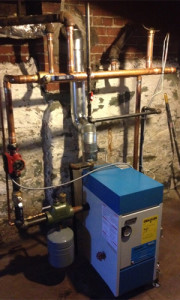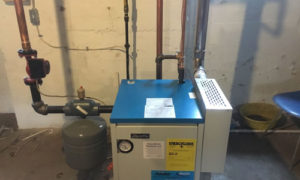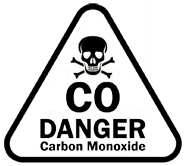There are two types of gas hot water boilers commonly installed for residential and commercial applications the direct vent and power vent models. The two vary in design and installation cost and also have differences in safety and energy consumption savings. Here are the differences between the two boilers, so when its time for you to have your boiler replaced you will know which one suits your purpose the best.
What’s the difference?
Direct vent boilers
Direct vent boiler

A direct vented or atmospheric gas hot water boiler vents its flue gas into a chimney or vent pipe that terminates above the roof. It draws air from the room it’s in for combustion in the burner chamber. It also always needs fresh air for the combustion to work efficiently. If not enough new air is available for the boiler it will start to backdraft and corrode at the top. That makes the boiler need to be replaced sooner than it normally should.
Since 2012 all manufactured hot water and steam boilers have an electronic ignition system. However, the electric ignition boilers need to be installed in a well-ventilated room that gets adequate combustion air. If there is no fresh air backdraft will occur during the heating cycles and failure or shut down of the boiler will happen. The modified direct vent boiler may require a flue liner, so the existing chimney liner doesn’t condensate and freeze. Freezing of the chimney liner will cause it to collapse internally after a period of time. Existing interior chimneys are less susceptible to freeze because they will stay warm from the inside rather than be cooled off from the outside. In situations when an interior chimney is available a direct vent boiler can be used without worry of the chimney failing.
Power vent boilers
Power vent boilers

The power vent boiler is more of a versatile boiler. Unlike the direct vent model it doesn’t need a chimney or vent pipe going to the roof to exhaust its flue gases. For instance, if you’re planning to remodel your basement and want to relocate the boiler, you don’t necessarily need a chimney. Also if you have chimney issues such as backdrafts blowing out the pilot light in your existing boiler, the direct vent boiler will eliminate these problems for you.
The power vent boiler can be installed anywhere in a home or building, but its makeup water supply, feed pipes, return pipes and gas pipe will have to move along with it. Relocation of an existing boiler requires extension all of its associated piping and keep that in mind. Depending on how far a boiler gets placed can increase the installation cost of relocation.
Safety and the efficiency differences
If there is a backdraft with the older direct vent boiler, it will allow carbon monoxide to build up creating a possibly deadly situation if it has no draft safety on its draft hood. However, if there’s a backdraft with the power vented boiler or newer direct vent boiler both will automatically shut down. Most chimneys are outside of the home, and if a modern direct vent boiler is installed, it could cause the existing chimney liner to freeze up. A power vent boiler eliminates the waste of money and time of installing a flue liner. I recommend the power vented model even though it may be a little more expensive.
What about your boiler?
Do you have concerns about your boiler? Schedule an appointment with Vince to inspect or replace your boiler.


